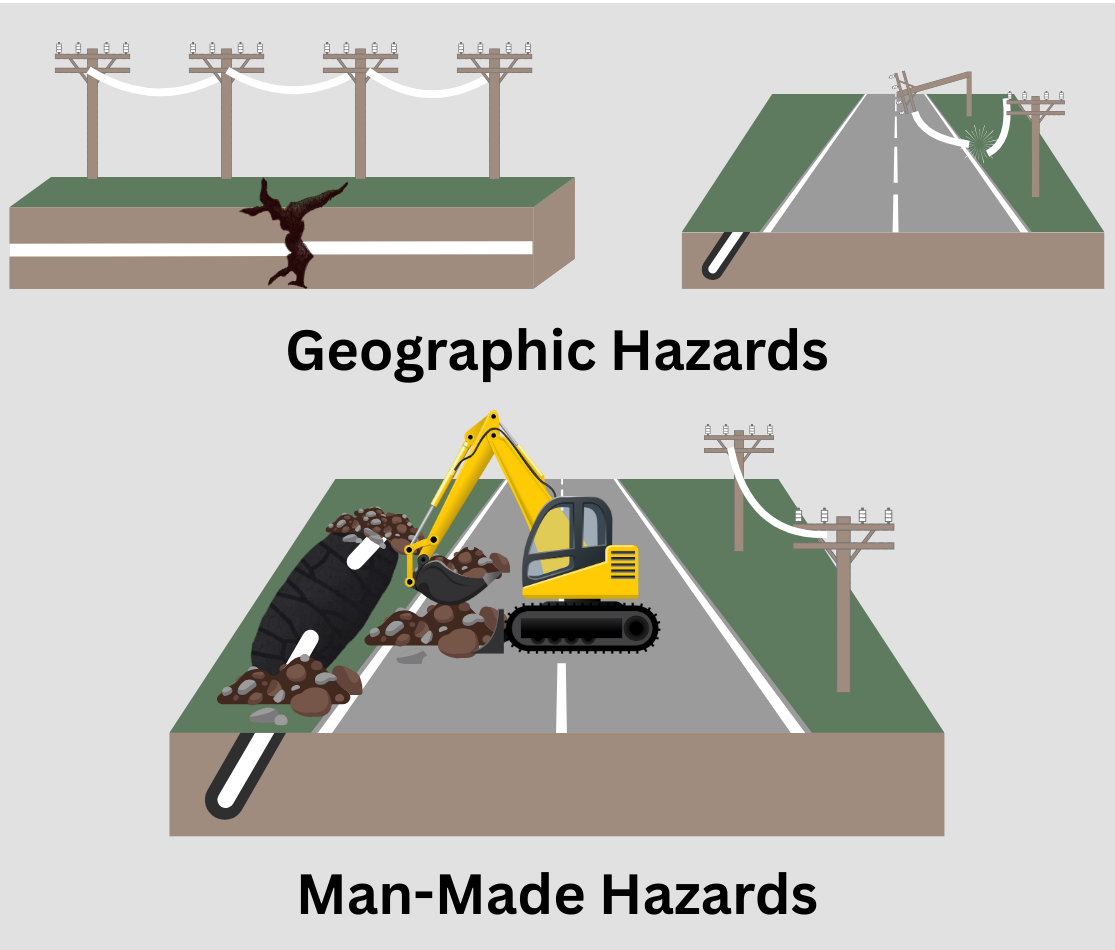
The Hidden Risks in Your Fiber Network:
Why Resiliency Is Critical
There are only so many highways in a country. That constraint can limit digital infrastructure that depends on public and private rights of way (RoW), especially backbone fiber-optic cable.
Often, a single RoW carries multiple fiber cables. These may belong to the same company or to different entities. Still, placing them diversely along the same route is vital for network strength and resilience. That principle is known as redundancy.
Route vs. Path
In the telecommunications industry, there is a distinction between route diversity and path redundancy.
Route diversity/resiliency is a reference to multiple geographically different corridors linking two locations. These might run along different roads or use entirely separate RoW, such as power line corridors, or rail lines. True route diversity means that if one corridor fails, another independent path can carry traffic.

Two distinct locations can be connected via multiple routes, these can be a combination of different RoW or different roads (usually highways).
Path resiliency, often called redundancy, is multiple fiber cables along the same route/RoW. Public utility corridors can be limiting, and so can project funding, making it not always practical to build many separate routes. Instead, providers run separate ducts or cables along the same route — for example, parallel fiber lines in the same highway trench. While cost-effective, this configuration introduces risk: if the RoW is compromised, all cables may go down together.
Optimal Redundancy Configurations
Not all redundancies are equal, there are good (and not so good) configurations.
Two cables trenched in the same duct is the lease resilient option, while even a separation of ducts and a couple of meters distance (can be side-by-side at the same depth, or can even be stacked with one ducted deeper and the other more shallow) can significantly reduce simultaneous cable failures.

These are just five of the many configurations of multiple (can be more than two) paths along a road RoW. Aligned from the least resilient (two cable in the same duct) to most resilient (opposite side of road, one aerial and one trenched).
In other cases, fiber may follow non-road infrastructure, such as power‑line or rail corridors, providing some geographic separation even while connecting the same end points. This means that operators can link the same cities, while also maintaining some geographic diversity.
Path Redundancy is Important...Why?
Fiber optic networks are open to both geographic and man-made hazards. Backbone networks especially need to survive when things go wrong.
Geographic hazards can include floods, earthquakes, storms, and wildfires. A flood could wash out a road and the ducted fiber beneath it, but aerial fiber along power poles might remain intact. Conversely, a windstorm might down poles, but underground fiber remains untouched. Redundant paths can localize failures, preventing a single event from taking down all connectivity.
Man-made risks are equally significant: construction is one of the most common causes of fiber outages. Field workers repairing or digging roads may not know exactly where fiber ducts lie, and they can accidentally sever cables. According to the FCC (2024), more than 50% of facility outages in the US are caused by construction activity that damages underground fiber.
There are instances of sabotage, as well. While more rare in highly regulated markets, it does occur in areas with less infrastructure oversight.

Just some of the ways fiber cuts can occur. With good path resiliency, if a fiber cable is damaged, this does not mean completed digital darkness.
Because of these threats, accurate maps of existing fiber, duct and conduit are essential. Shared, up-to-date infrastructure data helps utility and telecom companies avoid creating single points of failure.
Deployment Strategies: Trenched vs. Aerial
In many regions, trenched fiber along highways is the default deployment method. But for resilience, integrating aerial routes (e.g., using power-line poles) offers critical diversity.
Some providers go further: by deeply burying fiber — more than three feet underground — they reduce risk from construction, weather and even rodents. Others combine aerial and trenched paths to maximize redundancy while managing cost.
Increasing Global Interest
With environmental hazards on the rise and society’s dependence on digital infrastructure growing, there is a global push for resiliency in both new fiber deployments and upgrades to legacy networks. Understanding the nuances of route diversity and path redundancy is no longer optional. These decisions can determine whether networks stay online during critical events.
